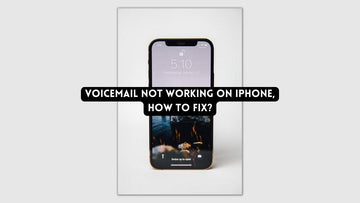How to fix Wi-Fi not working on Mac | Comprehensive Guide
by Chelsea Bruhl on Sep 26, 2024

Wi-Fi connectivity issues on your Mac? Check out How to fix Wi-Fi not working on Mac in this article.
Wi-Fi, don't you believe, should be added to Maslow's hierarchy of demands as a necessity for humanity in the 21st century?
Of course, I'm joking! However, it's nearly impossible to picture our world without the internet nowadays. So when it quits working, we feel helpless and powerless.
A fresh software update, incorrect Wi-Fi preferences, or many networks interfering with each other could be reasons why your Mac won't connect to Wi-Fi. I'll describe what you can do if your Wi-Fi won't connect or keeps falling off in the following sections.
The following are the most common symptoms of Wi-Fi issues on Mac:
- The Mac does not have internet access, but other gadgets do.
- Although Mac is connected to Wi-Fi, it does not have Internet access.
- The Wi-Fi connection is constantly dropping.
- On Mac, the Wi-Fi connection is slow or unstable.
In this article, MacSecurity will teach you how to fix Wi-Fi not working on Mac to help you fix any internet related issues you might be facing.
Related: How to fix macOS ‘WiFi: No Hardware Installed’ Error
How to fix Wi-Fi not working on Mac
Ways to fix Wi-Fi on Mac
Launch the Wireless Diagnostics

Starting with Wireless diagnostics is an excellent idea. You can do this with the native utility that comes with macOS.
- Click the Wi-Fi symbol in the upper right corner.
- Open the Wireless Diagnostics tab.
- Click "Continue" after selecting "Monitor my Wi-Fi connection" from the pop-up box.
You'll be given a thorough overview of your network possibilities, and the computer will walk you through several actions to try to diagnose and resolve your Wi-Fi issues.
If that doesn't work, now is a good opportunity to set up Wireless Monitoring on your Mac so it can keep track of your ongoing issues. Even though the results are incomprehensible to you, they may aid a professional in diagnosing your Wi-Fi issues in the future.
Restart macOS networking (AirPort) using Terminal
- From the Applications/Utilities directory, open the Terminal.
- Run the following commands to see if the issue has been resolved:
networksetup -setairportpower en0 off
networksetup -setairportpower en0 on
Delete the problematic connection
- Restart your computer.
- Select your Wi-Fi connection from the left pane under Network Preferences.
- Choose Make Service Inactive from the gear icon next to the connection.
- Click the minus icon to erase the connection after it has been disabled.
Reset Wi-Fi network settings
This step will reset your Wi-Fi settings and start the network experience from the beginning. But, before you start, I recommend using Time Machine to back up your Mac.
- Turn off Wi-Fi and shut down your browsers.
- Apple menu > Go > Go to Folder.
- Paste in the following line:
/Library/Preferences/SystemConfiguration/ - Select the files listed below
- preferences.plist
- com.apple.wifi.message-tracer.plist
- com.apple.network.eapolclient.configuration.plist
- com.apple.airport.preferences.plist
- NetworkInterfaces.plist
- Finally, copy these files to a new Desktop folder. Restart your computer.
After that, you'll have to go over your Wi-Fi settings again (Click Open Network Preferences under the Wi-Fi icon). Switch on Wi-Fi and pick your Wi-Fi network once more.
Follow the steps above when your Wi-Fi connection goes down after upgrading to the latest macOS.
Reset Wi-Fi sleep mode settings
Sleep mode settings on Mac can sometimes cause Wi-Fi to drop and not switch back on. Try this quick repair that a lot of people liked:
- Select Battery > Power Adapter from the System Preferences menu.
- For network access, disable the Wake feature.
Change your DNS settings
We're starting to get a little more technical now.
It's possible that your Wi-Fi is working perfectly but you're still unable to access the internet because your ISP's Domain Name Server (DNS) is down.
Instead, use a free, public DNS in these situations. Google provides one.
Open Network Preferences from the Wi-Fi icon in the top menu bar or System Preferences to give it a shot.
Then select "Advanced." Then, from the menu, choose DNS, click the plus button (as seen above), and enter the Google DNS addresses 8.8.8.8 or 8.8.4.4.
Click "OK" to resume your internet search.
Try the Wi-Fi connection in Safe Mode
In Safe Mode, test your Wi-Fi issue. Then exit Safe Mode (by restarting your Mac) and try to reconnect to Wi-Fi:
To Safe Boot your Intel Mac, follow these steps:
- Turn your Mac off.
- When your Mac starts up, hit and hold the Shift key.
- Hold the Shift key down until you get the login screen.
- Then log in; you may need to do this twice.
To Safe Boot your Apple silicon Mac, follow these steps:
Turn your Mac off.
- When the startup options box displays, press and hold the power button.
- Select a startup disc.
- Continue in Safe Mode by pressing and holding the Shift key.
- Then sign in.
Go to the Apple menu > About This Mac if you're not sure if your Mac is an Intel or Apple silicon model.
Reset NVRAM/PRAM and the SMC
Internal Mac components NVRAM (Non-Volatile Random-Access Memory) and PRAM (Parameter Random-Access Memory) store memory even when the device is turned off.
Resetting the PRAM/NVRAM, which is used in areas like your computer's internal clock, can be an effective way to clean out the virtual cobwebs and get your Wi-Fi back up and running.
While you're there, you should also reset the SMC (System Management Controller) for the same reason.
It's pretty simple to reset the PRAM/NVRAM:
- To access the PRAM/NVRAM, turn on the computer and hold the Shift, Control, and Option keys while pressing the power button on your Macbook for at least 10 seconds after hearing the startup chime.
- Press and hold the Command + Option + P + R keys to reset the PRAM immediately after hearing the starting chime.
Release these keys when you hear the starting sound a second time on older Macs, and after the apple logo shows and disappears twice on newer Macs. This holds true for desktop Macs as well.
Whether you have a Mac model with a replaceable battery or not, you can reset the SMC.
If your phone has a removable battery, simply remove it and press and hold the power button for five seconds.
Press Shift-Control-Option and the power button on all other Macs. Hold these keys and the power button together for 10 seconds before releasing them.
Reboot your Wi-Fi router
Leave your router turned off for a minute or two. After that, reconnect your router and try to connect other Wi-Fi devices in the room. In this manner, you can see if the issue is with the router.
Also, try moving your router to a different location. Because of nearby networks or a "dead zone" in your home, you may lose your Wi-Fi connection.
Reboot your Mac

It's also a good idea to turn your Mac off and on, just like the router.
If the problem persists after rebooting, try turning off the Wi-Fi for a few seconds and then turning it back on to force it to scan for accessible networks again.
To switch Wi-Fi off and on again, pick Turn Wi-Fi Off from the Wi-Fi logo in the menu bar at the top right of your Mac.
Switch off the Bluetooth

Bluetooth devices can cause Wi-Fi interference, especially if the Wi-Fi signal is poor. It's because they both operate on radio frequencies. Examining the Bluetooth settings is another way to help you solve your Wi-Fi on Mac.
Disconnect the Bluetooth and observe if the issue still exists.
- Select System Preferences from the Apple menu.
- Choose Bluetooth.
- After that, select Turn Bluetooth off.
Check your System Updates

When Mac customers have updated their laptops to a new version of macOS in the past, they have occasionally had Wi-Fi issues. This was a huge problem with the first edition of El Capitan (macOS 10.11) in 2015: many people discovered their Macs couldn't connect to their wireless network after the update.
Apple released a software update, but due to the lack of an Ethernet port on the MacBook Air, owners could only access the internet via Wi-Fi (unless they had an adapter). We had to update our Mac to the latest version of macOS while sharing the internet connection from our phone when we ran into this issue.
If you're using a beta version of macOS, you can also have issues with Wi-Fi. When we were testing the High Sierra beta, for example, we experienced a lot of issues with Wi-Fi dropping.
Conclusion
If none of the other suggestions worked, your hardware might be malfunctioning. You might notice a notification that says "no hardware installed," for example.
Alternatively, the network card may have failed. More information on your Wi-Fi gear can be found in the System Information section of your Mac.
If the issue is with your hardware then it is recommended that you take your Mac to a professional repair center and have them look at it.
A few users claimed that the ribbon cable had become detached from the wireless card and that the problem was rectified by reconnecting it tightly.
These are just a few quick fixes that can come in helpful if you can't get Wi-Fi to work on your Mac. We hope that your issue is resolved using thanks to our How to fix Wi-Fi not working on Mac guide.
Also Read:




